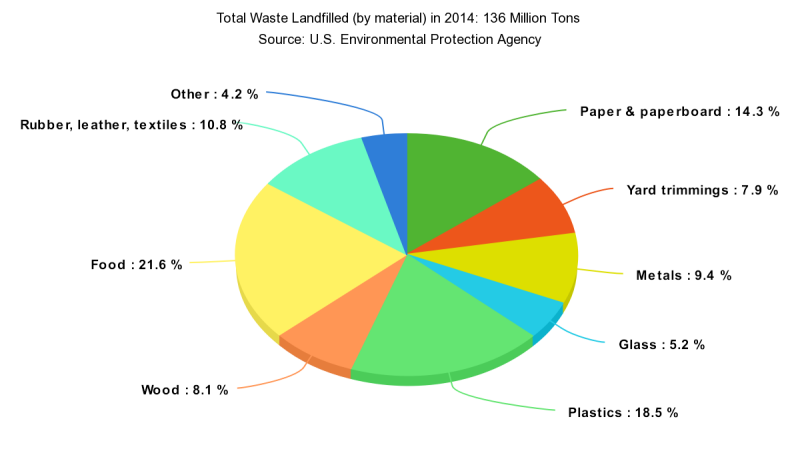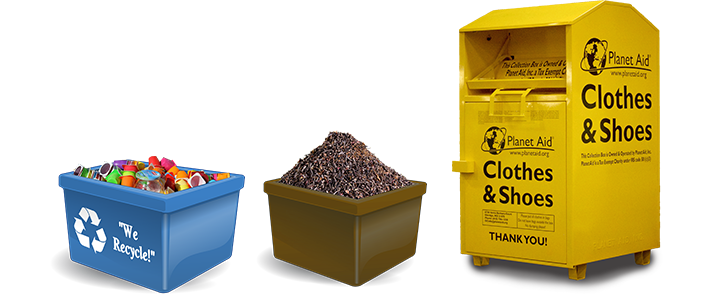How Things Rot
At one point or another, you've probably opened your refrigerator and been hit with a fetid smell that you quickly learn belongs to a bag of lettuce that is now limp and watery. After finding the culprit of that ostentatious stench, you gingerly pick it up by its wrapping and place it straight into the garbage bin.
From there, that rotting lettuce is picked up by your municipal refuse handlers and taken to a landfill, where it continues its decomposition along with everything else—the wrapping it was thrown out in, the milk carton you emptied the night before, the old T-shirt that you found a hole in, and the trash bag that it was all stuffed into.
At that point, it's out of your view and potentially out of your thoughts. But, that bag of trash has a long life ahead of it. A life that greatly contributes to global climate change. As you clean up and clean out this spring, keep the following in mind:

How Living Stuff Rots
Organic matter (that is, anything that was once living), like lettuce, naturally rots. When the rot happens "in the wild" it is wonderful for the environment. Rot, or decomposition, is the natural biological process of breaking down complex molecules into simpler forms. As this natural breakdown occurs, there are a number of products created: carbon dioxide (CO2), most of which is released into the air where it is transformed into oxygen by plants; energy (in the form of heat), which creates a thriving environment for micro- and macro-organisms; and plant nutrients, which are eaten by those micro- and macro-organisms. This further breaks down the matter and leaves excess nutrients in the soil, which are then absorbed by plants.
Composting is the decomposition process that most gardeners are familiar with. In composting, natural fertilizer is created by carefully monitoring the decomposition of organic household waste, which can include leaves, coffee grounds, egg shells, and even paper. By continually adding new organic waste and aerating the compost, the natural decomposition process is able to thrive. Good compost is great for gardens and house plants and can even help break down harmful chemicals in the soil. The Natural Resources Defense Council has great tips for starting and maintaining a household compost. Even if you live in an apartment, composting can be an easy and environmentally-friendly habit.
So, what about the T-shirt with the hole in it? It's 100 percent cotton, and cotton is a plant and was once living, so can you compost it? Technically, yes; realistically, no. Items that you want in your compost decompose in about a month; that T-shirt will take six months.

How the Rest Rots
Our lettuce will rot fairly quickly, but that plastic-covered milk carton that's in the same bag, it'll take about five years to fully decompose; while the trash bag it was all stuffed into will take at least 500 years, most estimates say more. While the excessively long-term decomposition of plastic, extruded polystyrene foam, and synthetic fabrics is daunting in itself, landfills present another issue.
In the Bowels of a Landfill
According to the National Solid Waste Management Association (NSWMA), landfills aren't designed to foster healthy breakdown of trash, they are designed to simply store it. Considering Americans dump about 370 thousand pounds of waste into landfills each day, we're looking at a lot of trash in storage—which becomes a big problem as it starts to decompose.
A large part of the natural decomposition process is oxygen (why gardeners and composters aerate). Landfills are tightly packed mounds of waste sitting on top if a lining of clay and thick plastic, and covered with another layer of clay and thick plastic. This creates a definite dearth of oxygen, making the bacteria created during decomposition release an excess of methane gas. Methane is extremely flammable, dangerous to store, and a strong greenhouse gas.
According to the U.S. Environmental Protection Agency (EPA), "landfills are the third-largest source of human-related methane emissions in the United States, accounting for approximately 15.4 percent of these emissions in 2015." Not only is that a lot of methane coming from landfills, but "[m]ethane is 28 to 36 times more effective than CO2 at trapping heat in the atmosphere… Landfills, and the methane they produce, are quickly and efficiently thickening the Earth's blanket.

Keeping Waste Out of Landfills
While we can't change the waste of the past, we can change the waste of the future. Doing all you can to reduce your waste, reuse what you can, and recycle everything that you don't reuse is a huge step. Already, Americans are recycling and composting around 35 percent of their waste, a large increase from the less-than-10-percent figure for 1985. Sadly, there's a long way to go, as the majority of what goes into a landfill could also have been recycled, reused, composted, or donated.

The Blue Bin, the Brown Bin, and the Yellow Bin
So, recycle everything! Put your glass and plastic in your curb-side blue bin, start a brown bin for your compost, bring your unwanted clothing and textiles to your closest yellow Planet Aid bin, and help bring down the continual methane emissions from your local landfill. For more information on what you can recycle, check out our blogs on the "Big Blue Bin" and "Household Items You Didn't Know You Could Recycle."

Visit our Spring page for tips and tricks on spring cleaning, recycling, gardening, and more!

